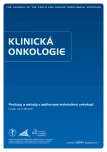Analysis of Protein Using Mass Spectrometry
Authors:
P. Dvořáková; L. Hernychová; B. Vojtěšek
Authors‘ workplace:
Regionální centrum aplikované molekulární onkologie, Masarykův onkologický ústav, Brno
Published in:
Klin Onkol 2014; 27(Supplementum): 104-109
Overview
Recently, mass spectrometry has become a powerful tool in cancer research. Mass spectrometry represents the method that allows identification, quantification and characterization of proteins in biological samples. Nowadays, it is mainly used for biomarker discovery that can enable early detection of cancer. This article is focused on protein analysis by mass spectrometry. At first, mass spectrometry and its importance in proteomics are described. Subsequently ionization type and mass analyzers are discussed. This relates to the possibility of on‑line or off‑line analysis connection with separation techniques, such as liquid chromatography and electrophoresis. Different approaches for preparing proteins and methods of analysis of biomolecules using mass spectrometers are described. In addition, the possibility of mass spectrometric analyses of samples and data processing are discussed.
Key words:
mass spectrometry – liquid chromatography – electrophoresis – proteomics
This work was supported by the European Regional Development Fund and the State Budget of the Czech Republic (RECAMO, CZ.1.05/2.1.00/03.0101) and by MH CZ – DRO (MMCI, 00209805).
The authors declare they have no potential conflicts of interest concerning drugs, products, or services used in the study.
The Editorial Board declares that the manuscript met the ICMJE “uniform requirements” for biomedical papers.
Submitted:
31. 1. 2014
Accepted:
25. 3. 2014
Sources
1. Griffiths J. A brief history of mass spectrometry. Anal Chem 2008; 80(15): 5678– 5683. doi: 10.1021/ ac8013065.
2. Fenn JB, Mann M, Meng CK et al. Electrospray ionization for mass spectrometry of large biomolecules. Science 1989; 246(4926): 64– 71.
3. Tanaka K, Waki H, Ido Y et al. Protein and polymer analyses up to m/ z 100 000 by laser ionization time‑ of‑ flight mass spectrometry. Rapid Commun Mass Spectrom 1988; 2(8): 151– 153.
4. Aebersold R, Mann M. Mass spectrometry‑based proteomics. Nature 2003; 422(6928): 198– 207.
5. Yates JR, Ruse CI, Nakorchevsky A. Proteomics by mass spectrometry: approaches, advantages, and applications. Annu Rev Biomed Eng 2009; 11: 49– 79. doi: 10.1146/ annurev‑ bioeng‑ 061008- 124934.
6. Holčapek M, Jirásko R, Lísa M. Recent developments in liquid chromatography‑mass spectrometry and related techniques. J Chromatogr A 2012; 1259: 3– 15. doi: 10.1016/ j.chroma.2012.08.072.
7. Wisniewski JR, Zougman A, Nagaraj N et al. Universal sample preparation method for proteome analysis. Nat Methods 2009; 6(5): 359– 362. doi: 10.1038/ nmeth.1322.
8. Monteoliva L, Albar JP. Differential proteomics: An overview of gel and non‑gel based approaches. Brief Func Genomic Proteomic 2004; 3(3): 220– 239.
9. Choi YS. Reaching for the depp proteome: recent nano liquid chromatography coupled with tandem mass spectrometry‑based studies on the deep proteome. Arch Pharm Res 2012; 35(11): 1861– 1870. doi: 10.1007/ s12272- 012-1102- y.
10. van Ulsen P, Kuhn K, Prinz T et al. Identification of proteins Neisseria meningitidis induced under iron‑limiting conditions using the isobaric tandem mass tag (TMT) labeling approach. Proteomics 2009; 9(7): 1771– 1781. doi: 10.1002/ pmic.200800642.
11. Shevchenko A, Tomas H, Havliš J et al. In‑ gel digestion for mass spectrometric characterization of protein and proteomes. Nature Publishing Group 2006; 1(6): 2856– 2860.
12. Olsen JV, Blagoev B, Gnad F et al. Global, in vivo, and site‑ specific phosphorylation dynamics in signaling networks. Cell 2006; 127(3): 635– 648.
13. Bogdanov B, Smith RD. Proteomics by FTICR mass spectrometry: top down and bottom up. Mass Spectrom Rev 2005; 24(2): 168– 200.
14. Lenco J, Stulik J. Identifikace proteinů kombinací peptidového mapování a fragmentace sulfonovaných peptidů. Chem Listy 2004; 98: 264– 267.
15. Henzel WJ, Watanabe C. Protein identification: The origins of peptide mass fingerprinting. J Am Soc Mass Spectrom 2003; 14(9): 931– 942.
16. Eng JK, McCormack AL, Yates JR. An approach to correlate tandem mass spectral data of peptides with amino acid sequences in a protein database. J Am Soc Mass Spectrom 1994; 5(11): 976– 989. doi: 10.1016/ 1044- 0305(94)80016- 2.
17. Perkins DN, Pappin DJ, Creasy DM et al. Probability‑based protein identification by searching sequence databases using mass spectrometry data. Electrophoresis 1999; 20(18): 3551– 3567.
18. Zhang Y, Ficarro SB, Li S et al. Optimized orbitrap HCD for quantitative analysis of phosphopeptides. J Am Soc Mass Spectrom 2009; 20(8): 1425– 1434. doi: 10.1016/ j.jasms.2009.03.019.
19. Zubarev RA, Kelleher NL, McLafferty FW. Electron capture dissociation of multiply charged protein cations. A nonergodic process. J Am Chem Soc 1998; 120(13): 3265– 3266.
20. Coon JJ, Ueberheide B, Syka JE et al. Protein identification using sequential ion/ ion reactions and tandem mass spectrometry. Proc Natl Acad Sci 2005; 102(27): 9463– 9468.
21. Syka JE, Coon JJ, Schroeder MJ et al. Peptide and protein sequence analysis by electron transfer dissociation mass spectrometry. Proc Natl Acad Sci 2004; 101(26): 9528– 9533.
22. Casado‑ Vela JC, Cebrián A, Gómez del Pulgar MT et al.Lights and shadows of proteomic technologies for the study of protein species including isoforms, splicing variats and protein post‑translation modifications. Proteomics 2011; 11(4): 590– 603. doi: 10.1002/ pmic.201000287.
Labels
Paediatric clinical oncology Surgery Clinical oncologyArticle was published in
Clinical Oncology

2014 Issue Supplementum
- Metamizole vs. Tramadol in Postoperative Analgesia
- Metamizole at a Glance and in Practice – Effective Non-Opioid Analgesic for All Ages
- Possibilities of Using Metamizole in the Treatment of Acute Primary Headaches
- Current Insights into the Antispasmodic and Analgesic Effects of Metamizole on the Gastrointestinal Tract
- Spasmolytic Effect of Metamizole
Most read in this issue
- Protein Expression and Purification
- Methods for Studying Tumor Cell Migration and Invasiveness
- Next Generation Sequencing – Application in Clinical Practice
- Analysis of Protein Using Mass Spectrometry
